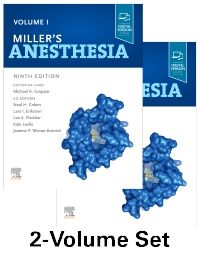Description
Covering everything from historical and international perspectives to basic science and current clinical practice,
Miller's Anesthesia, 9th Edition, remains the preeminent reference in the field. Dr. Michael Gropper leads a team
of global experts who bring you the most up-to-date information available on the technical, scientific, and clinical
issues you face each day – whether you’re preparing for the boards, studying for recertification, or managing a
challenging patient care situation in your practice.
Hyperthermia; Immediate and Long-Term Complications; Clinical Research; and Interpreting the Medical Literature.
readable and actionable.
Leslie
of the University of Melbourne and Royal Melbourne Hospital.
techniques, step-by-step instructions for patient management, the unique needs of pediatric patients, and much more –
all highlighted by more than 1,500 full-color illustrations for enhanced visual clarity.
VOLUME 1
Section I. Introduction
1. The Scope of Modern Anesthetic Practice
2. Anesthesia and Analgesia in the Global Context
Section 1: Anesthesia and “Global Health”
Section 2: Evolution of Anesthesia Care Models and Challenges Around the World
Section 3: Essentials for Practice in Resource-Constrained Settings
3. Perioperative Medicine
4. Informatics in Perioperative Medicine
5. Quality Improvement in Anesthesia Practice and Patient Safety
더보기
6. Avoiding Patient Harm in Anesthesia: Human Performance and Patient Safety
7. Patient Simulation
8. Ethical Aspects of Anesthesia Care
Section II. Anesthetic Physiology
9. Consciousness, Memory, and Anesthesia
10. Sleep Medicine
11. Cerebral Physiology and the Effects of Anesthetic Drugs
더보기
12. Neuromuscular Physiology and Pharmacology
13. Respiratory Physiology and Pathophysiology
14. Cardiac Physiology
15. Gastrointestinal Physiology and Pathophysiology
16. Hepatic Physiology, Pathophysiology, and Anesthetic Considerations
17. Renal Anatomy, Physiology, Pharmacology, and Evaluation of Function
18. Basic Principles of Pharmacology
19. Inhaled Anesthetics: Mechanisms of Action
20. Inhaled Anesthetic Uptake, Distribution, Metabolism, and Toxicity
21. Pulmonary Pharmacology and Inhaled Anesthetics
22. Inhaled Anesthetics: Delivery Systems
23. Intravenous Anesthetics
24. Opioids
25. Nonopioid Pain Medications
26. Intravenous Drug Delivery Systems
27. Pharmacology of Neuromuscular Blocking Drugs
28. Reversal (Antagonism) of Neuromuscular Blockade
29. Local Anesthetics
Section III. Anesthesia Management
30. Risk of Anesthesia
31. Preoperative Evaluation
32. Anesthetic Implications of Concurrent Diseases
더보기
33. Anesthetic Implications of Complementary and Alternative Therapies
34. Patient Positioning and Associated Risks
35. Neuromuscular Disorders Including Malignant Hyperthermia and Other Genetic Disorders
36. Cardiovascular Monitoring
37. Perioperative Echocardiography
38. Implantable Cardiac Pulse Generators: Pacemakers and Cardioverter-Defibrillators
39. Neurologic Monitoring
40. Monitoring the State of the Brain and Central Nervous System During General Anesthesia and S
41. Respiratory Monitoring
42. Renal Pathophysiology and Treatment for Perioperative Ischemia and Nephrotoxic Injury
43. Neuromuscular Monitoring
44. Airway Management in the Adult
45. Spinal, Epidural, and Caudal Anesthesia
46. Peripheral Nerve Blocks and Ultrasound Guidance for Regional Anesthesia
47. Perioperative Fluid and Electrolyte Therapy
48. Perioperative Acid-Base Balance
49. Patient Blood Management: Transfusion Therapy
50. Patient Blood Management: Coagulation
VOLUME 2
Section IV. Adult Subspecialty Management
51. Management of the Patient with Chronic Pain
52. Palliative Medicine
53. Anesthesia for Thoracic Surgery
더보기
54. Anesthesia for Cardiac Surgical Procedures
55. Anesthesia for Correction of Cardiac Arrhythmias
56. Anesthesia for Vascular Surgery
57. Anesthesia for Neurologic Surgery and Neurointerventions
58. Anesthesia for Bariatric Surgery
59. Anesthesia and the Renal and Genitourinary Systems
60. Anesthesia for Abdominal Organ Transplantation
61. Anesthesia for Organ Procurement
62. Anesthesia for Obstetrics
63. Anesthesia for Fetal Surgery and Other Fetal Therapies
64. Anesthesia for Orthopedic Surgery
65. Geriatric Anesthesia
66. Anesthesia for Trauma
67. Prehospital Care for Medical Emergencies and Trauma
68. Biological, Natural, and Human-Induced Disasters: The Role of the Anesthesiologist
Section 1: Natural Disasters
Section 2: Acts of Terrorism
Section 3: Chemical, Biological, Radiological, and Nuclear Warfare
Section 4: Epidemic and Pandemic Infectious Outbreaks
69. Anesthesia for Ophthalmic Surgery
70. Anesthesia for Otolaryngologic and Head-Neck Surgery
71. Anesthesia for Robotic Surgery
더보기
72. Ambulatory (Outpatient) Anesthesia
73. Non-Operating Room Anesthesia
74. Clinical Care in Extreme Environments: Physiology at High Altitude and in Space
75. Clinical Care in Extreme Environments: High Pressure, Immersion, Drowning, Hypo- and Hypert
Section V. Pediatric Anesthesia
76. Regional Anesthesia in Children
77. Pediatric Anesthesia
78. Anesthesia for Pediatric Cardiac Surgery
79. Pediatric and Neonatal Critical Care
Section VI. Postoperative Care
80. The Postanesthesia Care Unit
81. Acute Postoperative Pain
82. Cognitive Dysfunction and Other Long-Term Complications of Surgery and Anesthesia
Section VII. Critical Care Medicine
83. Critical Care Anesthesiology
84. Neurocritical Care
85. Extracorporeal Membrane Oxygenation and Cardiac Devices
86. Cardiopulmonary Resuscitation and Advanced Cardiac Life Support
Section VIII. Ancillary Responsibilities and Problems
87. Acute and Anesthetic Care of the Burn-Injured Patient
88. Occupational Safety, Infection Control, and Substance Abuse
89. Clinical Research
90. Interpreting the Medical Literature
Index


